
Drosophila is a genus of flies, belonging to the family Drosophilidae, whose members are often called "small fruit flies" or pomace flies, vinegar flies, or wine flies, a reference to the characteristic of many species to linger around overripe or rotting fruit. They should not be confused with the Tephritidae, a related family, which are also called fruit flies ; tephritids feed primarily on unripe or ripe fruit, with many species being regarded as destructive agricultural pests, especially the Mediterranean fruit fly.

Drosophila melanogaster is a species of fly in the family Drosophilidae. The species is often referred to as the fruit fly or lesser fruit fly, or less commonly the "vinegar fly", "pomace fly", or "banana fly". Starting with Charles W. Woodworth's 1901 proposal of the use of this species as a model organism, D. melanogaster continues to be widely used for biological research in genetics, physiology, microbial pathogenesis, and life history evolution. As of 2017, six Nobel Prizes have been awarded to drosophilists for their work using the insect.

Michael Ashburner was an English biologist and Professor in the Department of Genetics at University of Cambridge. He was also the former joint-head and co-founder of the European Bioinformatics Institute (EBI) of the European Molecular Biology Laboratory (EMBL) and a Fellow of Churchill College, Cambridge.
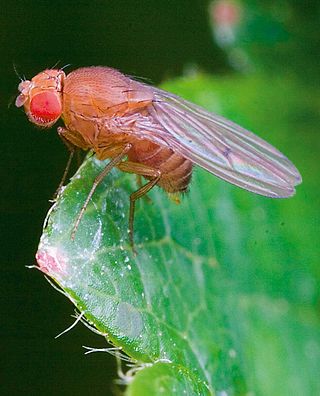
Drosophila simulans is a species of fly closely related to D. melanogaster, belonging to the same melanogaster species subgroup. Its closest relatives are D. mauritiana and D. sechellia.
The Drosophila melanogaster species subgroup contains 9 species of flies, including the best known species Drosophila melanogaster and D. simulans. The subgroup belongs to the Drosophila melanogaster species group within the subgenus Sophophora.
FlyBase is an online bioinformatics database and the primary repository of genetic and molecular data for the insect family Drosophilidae. For the most extensively studied species and model organism, Drosophila melanogaster, a wide range of data are presented in different formats.
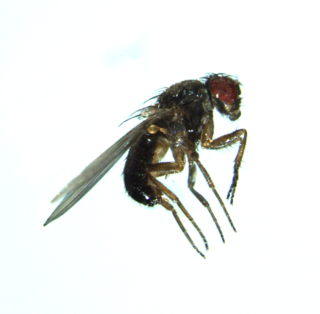
Drosophila pseudoobscura is a species of fruit fly, used extensively in lab studies of speciation. It is native to western North America.

Most animal testing involves invertebrates, especially Drosophila melanogaster, a fruit fly, and Caenorhabditis elegans, a nematode. These animals offer scientists many advantages over vertebrates, including their short life cycle, simple anatomy and the ease with which large numbers of individuals may be studied. Invertebrates are often cost-effective, as thousands of flies or nematodes can be housed in a single room.
The Baylor College of Medicine Human Genome Sequencing Center (BCM-HGSC) was established by Richard A. Gibbs in 1996 when Baylor College of Medicine was chosen as one of six worldwide sites to complete the final phase of the international Human Genome Project. Gibbs is the current director of the BCM-HGSC.
Sexual antagonistic co-evolution is the relationship between males and females where sexual morphology changes over time to counteract the opposite's sex traits to achieve the maximum reproductive success. This has been compared to an arms race between sexes. In many cases, male mating behavior is detrimental to the female's fitness. For example, when insects reproduce by means of traumatic insemination, it is very disadvantageous to the female's health. During mating, males will try to inseminate as many females as possible, however, the more times a female's abdomen is punctured, the less likely she is to survive. Females that possess traits to avoid multiple matings will be more likely to survive, resulting in a change in morphology. In males, genitalia is relatively simple and more likely to vary among generations compared to female genitalia. This results in a new trait that females have to avoid in order to survive.
Drosophila sechellia is a species of fruit fly, used in lab studies of speciation because it can mate with Drosophila simulans.
Drosophila montana, colloquially referred to as a fruit fly, is a species of fly belonging to the family Drosophilidae and the genus Drosophila. It belongs to the montana phylad, which diverged from the D. virilis species group in South Asia before its migration into North America. It is typically found in the western United States, but has been seen in Europe and Asia. There are two color phases of the species, having either a yellowish or a blackish brown thorax. It is the species of Drosophila best adapted to cold environments.

Scaptomyza flava is an herbivorous leaf mining fly species in the family Drosophilidae. In Latin, flava means golden or yellow. The fly is amber to dark brown in color and approximately 2.5 mm in length. In Europe and New Zealand the larvae are pests of plants in the order Brassicales, including arugula, brassicas, broccoli, Brussels sprouts, bok choy, cabbage, canola, cauliflower, horseradish, kale, kohlrabi, napa cabbage, nasturtium, radish, rapini, rutabaga, turnip, wasabi and watercress. In New Zealand, its range has expanded to include host species that are intercropped with salad brassicas, including gypsophila, otherwise known as baby's breath, which is in the pink family (Caryophyllaceae) and the pea in the Fabaceae. More typically, S. flava is oligophagous within the Brassicales. Scaptomyza are unusual within the Drospophilidae because the group includes species that are truly herbivorous. Other herbivorous drosophilids include D. suzukii, which attacks fruit very early during ripening and species within the genus Lordiphosa, from Africa and Asia, which also include leaf miners. Most drosophilids feed on microbes associated with decaying vegetation and sap fluxes.
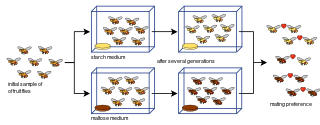
Laboratory experiments of speciation have been conducted for all four modes of speciation: allopatric, peripatric, parapatric, and sympatric; and various other processes involving speciation: hybridization, reinforcement, founder effects, among others. Most of the experiments have been done on flies, in particular Drosophila fruit flies. However, more recent studies have tested yeasts, fungi, and even viruses.
Metavirus is a genus of viruses in the family Metaviridae. They are retrotransposons that invade a eukaryotic host genome and may only replicate once the virus has infected the host. These genetic elements exist to infect and replicate in their host genome and are derived from ancestral elements unrelated from their host. Metavirus may use several different hosts for transmission, and has been found to be transmissible through ovule and pollen of some plants.

The Drosophila quinaria species group is a speciose lineage of mushroom-feeding flies studied for their specialist ecology, their parasites, population genetics, and the evolution of immune systems. Quinaria species are part of the Drosophila subgenus.

Drosophila innubila is a species of vinegar fly restricted to high-elevation woodlands in the mountains of the southern USA and Mexico, which it likely colonized during the last glacial period. Drosophila innubila is a kind of mushroom-breeding Drosophila, and member of the Drosophila quinaria species group. Drosophila innubila is best known for its association with a strain of male-killing Wolbachia bacteria. These bacteria are parasitic, as they drain resources from the host and cause half the infected female's eggs to abort. However Wolbachia may offer benefits to the fly's fitness in certain circumstances. The D. innubila genome was sequenced in 2019.
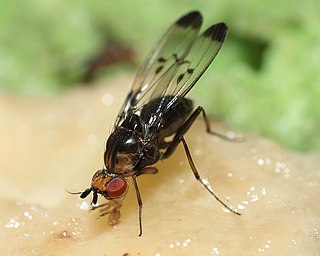
Drosophila silvestris is a large species of fly in the family Drosophilidae that are primarily black with yellow spots. As a rare species of fruit fly endemic to Hawaii, the fly often experiences reproductive isolation. Despite barriers in nature, D. silvestris is able to breed with D. heteroneura to create hybrid flies in the laboratory.
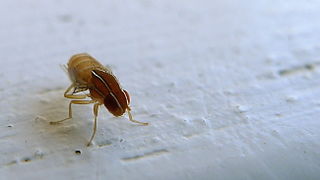
Zaprionus tuberculatus is a member of the subgenus and genus Zaprionus, family Drosophilidae, and order Diptera. It is an invasive fruit fly that originated in Africa, but can also be found in Europe and Asia. The fly earned its common name, the "vinegar fly", because researchers frequently captured the species using vinegar traps. Z. tuberculatus was previously considered a strictly tropical fly, but evidence of invasion to nontropical regions such as Turkey has been shown.

The Hawaiian Drosophilidae are a lineage of flies within the genus Drosophila. This monophyletic clade includes all of the endemic Hawaiian Drosophila and all members of the genus Scaptomyza, which contains both Hawaiian and non-Hawaiian species. The Hawaiian Drosophilidae are descended from a common ancestor estimated to have lived 25 million years ago. Species of Hawaiian Drosophilidae flies have been studied as models of speciation and behavioral evolution. Along with other members of the native Hawaiian ecosystem, the conservations status of many species of Hawaiian Drosophilidae is threatened by habitat loss and introduced predators, among other factors.













